Sherlock Holmes
![]()
This article is about the novel character. For other articles about movies, games and books of the same name, see Sherlock Holmes (disambiguation).
Sherlock Holmes [ˈʃɜ(ɹ).lɒk ˈhoʊ̯mz] ( ![]() ) is an artificial character created in 1886 by British writer Arthur Conan Doyle, who acts as a detective in his novels set in the late 19th and early 20th centuries.
) is an artificial character created in 1886 by British writer Arthur Conan Doyle, who acts as a detective in his novels set in the late 19th and early 20th centuries.
Doyle's works gained special significance for crime literature through the described forensic working method, which is based on detailed observation and sober conclusion. Holmes' friend and companion Dr. Watson usually serves as the chronicler of the investigation and mediator for the reader. Holmes is widely regarded to this day as a symbol of the successful, analytical, rational thinker and a stereotype of the private detective. The canon surrounding the detective includes 56 short stories and four novels.
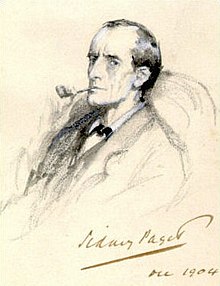
Sherlock Holmes , charcoal drawing by Sidney Paget, 1904
Design of the main character
From the canon of works surrounding Sherlock Holmes, a comprehensive picture of the detective can be gained. However, some details of his biography have contradictions that allow readers and critics their own interpretations. Conan Doyle himself explained that these inconsistencies stem from the careless handling of the material and the long period of writing.
Basics
In the first story, the novel A Study in Scarlet, Holmes is introduced as a self-confident, extremely scientifically oriented chemistry student who cultivates a variety of interests away from common careers with the goal of making his ideas of detective work feasible. In this novel the foundation is laid for the works that follow: The particular character of the matter-of-fact rational observer, the setting of the stories, and the friendly relationship of Holmes and Watson.
Holmes' character is defined by his intellectual abilities and his exceptionally no-nonsense, accurate and effective way of working. This often led others to associate him with a machine in the stories.
In the stories, however, Holmes also displays emotional traits such as likes and dislikes, humor, empathy, anger or fear, moral judgment, and a love of music. He plays the violin for relaxation and owns, among other things, a Stradivarius violin. At the same time, he combines many role-typical characteristics from the period of origin, such as that of the dandy.
It is implied that he is financially independent and can spend several weeks in his apartment without orders. In this context, Watson often sees him smoking in an armchair or playing the violin.
Appearance
Sherlock Holmes is often depicted as a tall (over six feet, about 1.83 meters), slender man. His face is described in some stories as prominent, gaunt, angular, and "ravenous" because he has a pointed hawk nose. Further, he is also described in some stories as pale and pale-faced. In one story, it is said that his grey eyes lit up when he thought of the solution to the case. His hair color varies from black to dark brown to light gray.
In London, Holmes is usually dressed like a normal middle-class city dweller. In the countryside, he wears either a long gray traveling coat, a winter jacket, an overcoat, or a raincoat. In the evening, he wears a red and gold dressing gown in all the stories.
The Deerstalker cap, which has become a trademark of the detective, is explicitly mentioned in only one of Doyle's stories: in The Adventure of Silver Blaze as "an ear flapped travelling cap". The popular stereotypical appearance of the detective with Inverness coat and hunting cap goes back to the illustrations of Sidney Paget.
Personal background and career
Holmes' family appears in the person of his brother Mycroft Holmes, whom Holmes describes in the story The Greek Interpreter as even more gifted than himself, although Mycroft is a phlegmatic, indolent character, so that he has no ambition to work as a detective. Among other things, Mycroft is a political advisor in British government service (described in more detail in "The Bruce-Partington Plans") and one of the founding members of the Diogenes Club, which Holmes calls the club of "the most unsociable men in London." In the same story, we also learn that one of Holmes' grandmothers is the sister of the French painter Horace Vernet.
The story The Adventure of the Gloria Scott (Engl. The Gloria Scott) shows the circumstances that led Sherlock Holmes to take up the profession of detective: The father of a college friend complimented him on his skills as an observer after being confronted with them himself. During his final semesters at university, Holmes was already beginning to work as a detective, with cases brought to him by fellow students, as Holmes recounts in The Adventure of The Musgrave Ritual, his third case from this period. The two stories are the only ones that take place before Holmes meets Watson, and thus chronologically before A Study in Scarlet.
In later stories, Watson reports that Holmes retires from public life at the turn of the century and devotes himself to beekeeping in Sussex. The Adventure of the Lion's Mane is set there at the time of his retirement. In the story His Last Bow, Holmes is reactivated as a secret agent on behalf of the government on the eve of the First World War, when he convicts a German spy.
Holmes' "dark sides"
In some stories, reference is made to Holmes' drug use. Holmes is a heavy smoker, smoking pipe, cigar, and cigarettes. The frequency and amount of consumption seem to change depending on his feelings, stress, and boredom - quite the opposite of his rational nature. Watson is therefore more often concerned about his friend's health and mental faculties.
In the second novel, The Sign of Four, Dr. Watson reports that Holmes uses cocaine and morphine at times of lack of intellectual pursuits, which Watson cites as Holmes's only vice that causes conflict between the two. "What is it today, cocaine or morphine?" Watson irritably asks his friend in the first chapter.
At the time the stories were written, morphines were freely available in pharmacies and were not subject to medical prescription. Cocaine was not yet banned as a drug; its positive effects were appreciated and it was widely used in everyday life. When the addictive effect became known, Conan Doyle worked this into the further stories. In the last stories, Holmes stopped his drug use. In The Adventure of the Missing Three-Quarter, Watson reports that he succeeded in dissuading Holmes from his "drug mania" and thus perhaps saved his detective career.
It is occasionally stated as debilitating that Holmes is still most concerned with the solution of an assignment, which is why even a visit to an opium den may not tempt him.
Holmes's tendency to break the law in particular emergencies points to Conan Doyle's own sense of morality and his strong sense of justice. In the very first story, A Scandal in Bohemia, Holmes instigates Watson to throw a lighted candle through an open window in order to fake a distracting fire. In Charles Augustus Milverton, Holmes and Watson commit a burglary and witness a murder unnoticed; the detective prevents Watson from intervening in the event and allows the murderess to escape out of moral understanding.
Holmes in the illustrations
Most of the Holmes stories in Strand magazine were illustrated by Sidney Paget, who chose his brother Walter as the model for the detective and depicted Holmes as a slender, tall aesthete with striking facial features and increasing receding hairline. The detective's popular external distinguishing marks can be traced back to Sidney Paget's illustrations: the illustrator himself liked to wear a deerstalker hat in private, which is why he often depicted Holmes wearing such a hunting cap while traveling. Holmes' Inverness coat is also Paget's invention, but is rarely seen in the pictures. Paget's illustrations usually show Holmes in the countryside wearing a cloak with a hood. The deerstalker and cloak first appear in an illustration for The Boscombe Valley Mystery in 1891 and again in The Adventure of Silver Blaze in 1893. They also appear in several illustrations in the anthology The Return of Sherlock Holmes.
The first German editions were illustrated between 1902 and 1908 by Richard Gutschmidt, who based his illustrations on Doyle's description and depicted Holmes as a British gentleman.
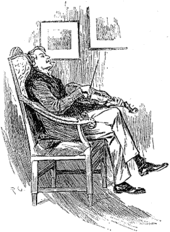
Sherlock Holmes with violin, illustration by Richard Gutschmidt, 1902
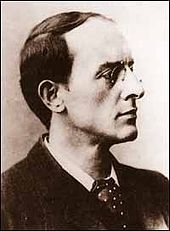
Walter Paget (c. 1893)
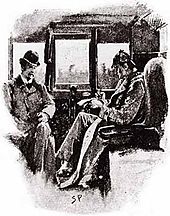
Sherlock Holmes (right) with deerstalker hat and check coat, illustration by Sidney Paget, 1891

Holmes in a dressing gown, Sidney Paget, 1891
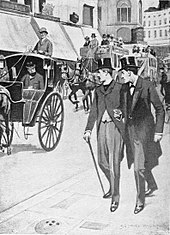
Holmes (right) and Watson in London, illustration by Sidney Paget, 1901
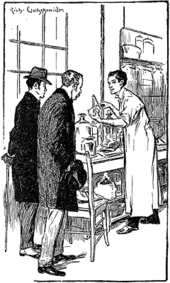
Holmes' (right) first appearance as a chemistry student, illustration by Richard Gutschmidt, 1902.
Other characters
→ Main article: Dr. Watson, Professor Moriarty, and characters in the Sherlock Holmes stories.
Questions and Answers
Q: Who wrote the books featuring Sherlock Holmes?
A: The books featuring Sherlock Holmes were written by Sir Arthur Conan Doyle.
Q: What is the most famous story about Sherlock Holmes?
A: The most famous story about Sherlock Holmes is The Hound of the Baskervilles.
Q: When was Sherlock Holmes "born"?
A: Sherlock Holmes was "born" on 6th January 1861.
Q: What are some details that make Sherlock Holmes recognizable?
A: Some details that make Sherlock Holmes recognizable are his hawk-like features and piercing eyes, dressing-gown and pipe, unusual cap and magnifying glass.
Q: Who does he work with to solve cases?
A: He works with his friend Dr. Watson, a retired army officer, to solve cases.
Q: What activities does he enjoy doing in his free time?
A: In his free time, he enjoys playing the violin and smoking a pipe.
Q: How did he first appear in literature?
A:He first appeared in literature in 1887.
Search within the encyclopedia